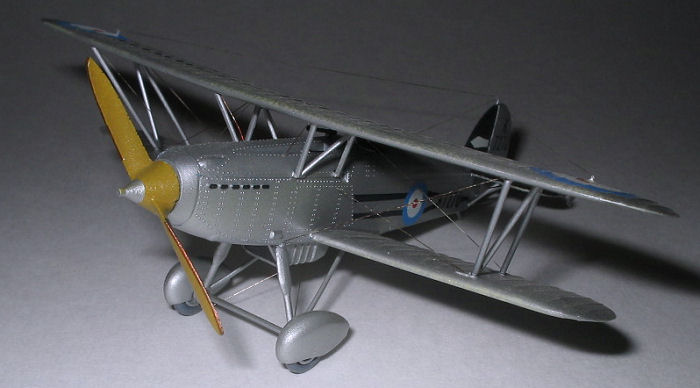
| KIT #: | PK-1 |
| PRICE: | $Currently out of production |
| DECALS: | Two options |
| REVIEWER: | Brian Baker |
| NOTES: |

| HISTORY |
After development of the immensely successful series of Hawker Hart light bombers, Sydney Camm developed a similar but related fighter development, initially known as the Hornet, and powered by a 420 hp. in-line liquid cooled Rolls Royce F.XI engine, soon to be known as the Kestrel. Tests at Martelsham Heath proved beyond a doubt that the airplane was superior to the Bristol Bulldog, then entering service with the RAF in the early thirties. Even though it was a better performing aircraft, the Fury, as it was renamed to coincide with a newly adopted RAF policy of naming fighters with words beginning in “F”, went into only limited production, and initially equipped only the elite No. 1, No. 25, and No, 43 squadrons, which were considered the spearhead of the RAF’s fighter defense during the early and middle thirties. Later, a few served with various training establishments. Another factor that prevented its widespread use, aside from economic conditions caused by the Great Depression, was the aircraft’s relatively high cost compared to the Bulldog.
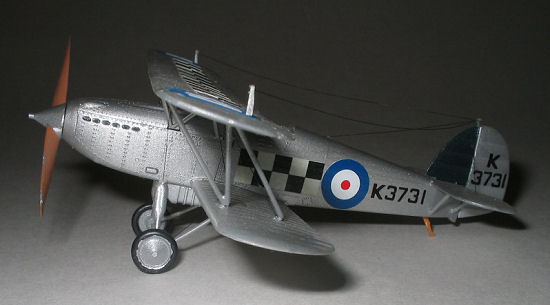 The Fury was a relatively
small, single seat Kestrel powered biplane fighter, armed with two .303 inch
Vickers guns with 600 rounds per gun. All versions had a span of 30 feet, while
Kestrel variants were 26 feet 8 inches long, with radial engine variants being
slightly shorter. Performance varied with the powerplant installed, with Kestrel
powered variants exceeding the 200 mph. mark, while some of the lower powered
radial engine types were slightly slower. Pilots were impressed with the
aircraft’s rapid climb, high maximum speed, and impressive maneuverability. It
was the last classic liquid-cooled engine fighter biplane in the RAF, subsequent
replacements including the Gauntlet and Gladiator. Only 118 Furies were
produced for the RAF, but an additional 32 were exported. Notwithstanding the
low production figures, the Fury will always be considered a classic fighter
biplane, and we are fortunate to have a good kit available in 1/72 scale, and
also in 1/48 by Airfix and Merit. . I understand that at least one full scale
replica has been built in England, serialed K-1329, and a 70% scale flying
replica called the Isaac Fury has also been built and flown in the UK.
The Fury was a relatively
small, single seat Kestrel powered biplane fighter, armed with two .303 inch
Vickers guns with 600 rounds per gun. All versions had a span of 30 feet, while
Kestrel variants were 26 feet 8 inches long, with radial engine variants being
slightly shorter. Performance varied with the powerplant installed, with Kestrel
powered variants exceeding the 200 mph. mark, while some of the lower powered
radial engine types were slightly slower. Pilots were impressed with the
aircraft’s rapid climb, high maximum speed, and impressive maneuverability. It
was the last classic liquid-cooled engine fighter biplane in the RAF, subsequent
replacements including the Gauntlet and Gladiator. Only 118 Furies were
produced for the RAF, but an additional 32 were exported. Notwithstanding the
low production figures, the Fury will always be considered a classic fighter
biplane, and we are fortunate to have a good kit available in 1/72 scale, and
also in 1/48 by Airfix and Merit. . I understand that at least one full scale
replica has been built in England, serialed K-1329, and a 70% scale flying
replica called the Isaac Fury has also been built and flown in the UK.
British variants included the Fury, later known as the Fury I when the Fury II came along, the intermediate Fury, which was a developmental test bed for the Fury II; the Fury II, with increased power and wheel pants; and the High Speed Fury, which featured tapered wings, modified “V” struts, and a more powerful engine. Another similar variant, designated P.V. 3, used a steam cooled Goshawk engine.
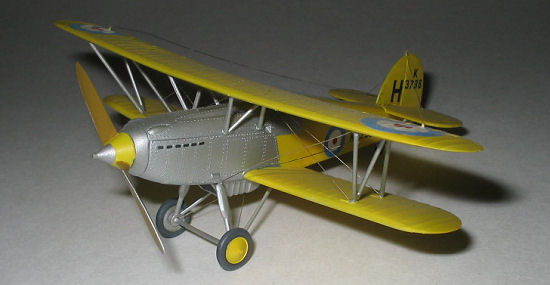 Perhaps the more interesting
Furies were the export versions. Standard production Furies were exported to
Yugoslavia, Norway, Persia, and Portugal. In addition, some Ex-RAF aircraft
went to South Africa, where they were used against the Italians during World War
II. Yugoslavia produced about 40 modified Furies with cantilever landing gear
and more powerful engine, and some of these wound up with the Spanish
Republicans, and when that war was over, the Spanish Franco government. Some
ex-Yugoslav Furies were used be the Italians as fighter trainers with mixed
markings. The Persian Furies had Pratt & Whitney Hornet radials, but these
were later replaced by Bristol Mercury engines for added performance. Check
your sources when doing a modified Fury, as there were many variations. The
last development was the Nimrod, similar to the Fury but with swept and extended
wings and carrier arrestor gear. You can’t really just extend the wings of a
Fury to make a Nimrod, although I did it years ago before I obtained reasonable
resources. The only Norwegian Fury used an Armstrong Siddelely Panther IIIA
radial engine, a most unique powerplant when mounted in front of a standard
Fury.
Perhaps the more interesting
Furies were the export versions. Standard production Furies were exported to
Yugoslavia, Norway, Persia, and Portugal. In addition, some Ex-RAF aircraft
went to South Africa, where they were used against the Italians during World War
II. Yugoslavia produced about 40 modified Furies with cantilever landing gear
and more powerful engine, and some of these wound up with the Spanish
Republicans, and when that war was over, the Spanish Franco government. Some
ex-Yugoslav Furies were used be the Italians as fighter trainers with mixed
markings. The Persian Furies had Pratt & Whitney Hornet radials, but these
were later replaced by Bristol Mercury engines for added performance. Check
your sources when doing a modified Fury, as there were many variations. The
last development was the Nimrod, similar to the Fury but with swept and extended
wings and carrier arrestor gear. You can’t really just extend the wings of a
Fury to make a Nimrod, although I did it years ago before I obtained reasonable
resources. The only Norwegian Fury used an Armstrong Siddelely Panther IIIA
radial engine, a most unique powerplant when mounted in front of a standard
Fury.
Three standard Furies were exported to Portugal in 1934, and the last one was written off in1937 when it was shot down at sea during the Spanish Civil War.
| THE KIT |
PK-1 was Matchbox’s first kit in
their prolific 1/72 scale series that first appeared in 1972, and unlike some of
the kits in this series, the Fury was accurate and easy to construct.
Consisting of 26 clear plastic parts in medium blue and beige, and one clear
windshield (Some kits included more than one windshield), the parts are detailed
with finely raised panel line and rivets, although
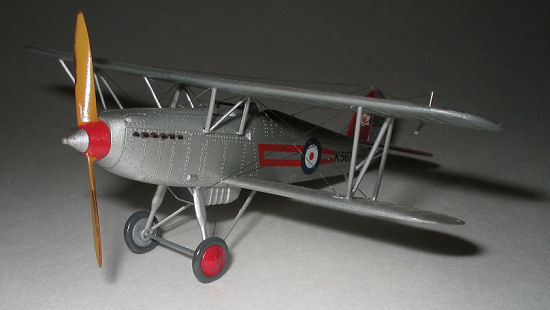 this plane was built before
flush riveting, so the raised rivets are acceptable. Fabric detail is not
excessive, and is effective once the model is painted. The decals, for one RAF
machine No. 43 Squadron, and one British built Yugoslav Fury, were pretty good
for their day, but the thirty year old decals I have in kit boxes have largely
deteriorated, as this was long before manufacturers started packaging their
decals in sealed plastic bags for preservation.
this plane was built before
flush riveting, so the raised rivets are acceptable. Fabric detail is not
excessive, and is effective once the model is painted. The decals, for one RAF
machine No. 43 Squadron, and one British built Yugoslav Fury, were pretty good
for their day, but the thirty year old decals I have in kit boxes have largely
deteriorated, as this was long before manufacturers started packaging their
decals in sealed plastic bags for preservation.
Biplanes seem to be notoriously difficult to construct, so Matchbox developed a new system of wing alignment. Unlike Monogram kits of the same vintage (The P-6E, F4B-4, and F11C-2), the Matchbox kit uses the cabane struts on a flat mounting that, when glued together, forms the right angle for the struts instead of molding the cabane struts directly to the fuselage. The strut assembly simply attaches to the cowl deck and engine cover, and the whole thing attaches to the top front of the fuselage, allowing the top wing to be installed in the correct position. It is next to idiot proof, although someday we’ll probably breed better idiots to counter this. The lower wing panels are cast in one piece, so dihedral angle is a shoo-in. This is one of the easiest biplanes you’ll ever build in 1/72 scale. I would suggest mounting the lower wing in position on the fuselage and then installing the top wing on the cabanes, and afterward putting the “N” struts in afterwards, as they will literally pop into place.
| CONSTRUCTION |
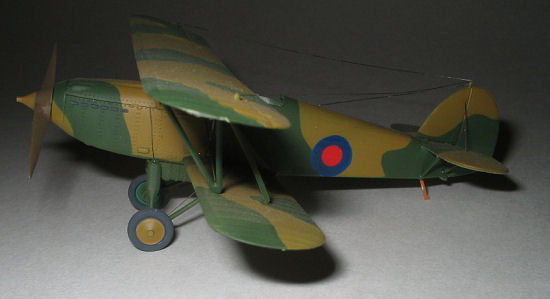 Fuselage assembly is
straightforward, and even the cockpit detail is not bad, although you might want
to do some detailing, as the seat is oversimplified and there is no control
stick. The instrument panel is cast into the fuselage sides, but a paper or
thin plastic panel can be inserted easily. If you use the pilot supplied in the
kit, you won’t be able to see inside of the cockpit anyway, but I don’t use
these, so I did the detailing.
Fuselage assembly is
straightforward, and even the cockpit detail is not bad, although you might want
to do some detailing, as the seat is oversimplified and there is no control
stick. The instrument panel is cast into the fuselage sides, but a paper or
thin plastic panel can be inserted easily. If you use the pilot supplied in the
kit, you won’t be able to see inside of the cockpit anyway, but I don’t use
these, so I did the detailing.
The prop is designed to fit into the front of the cowling, so it can easily be painted before installation. It is one of the finer features of the kit, and really sets the model off nicely.
The landing gear provides main struts and a spreader bar, with a detailed radiator assembly installed between the struts in realistic fashion. Smaller parts, such as the gunsight, tailskid,. and windshield, (or maybe I should say windscreen, since this is a British aircraft), are the last things to install.
RIGGING
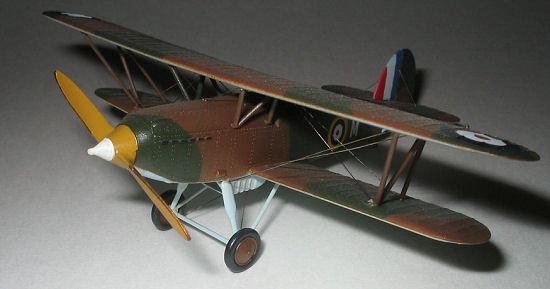 The only thing not mentioned
in the kit instructions, which are graphic and clear, is the rigging details.
The pylon mounts on the wing for the wire radio antenna are cast on the tops of
the wings, but I would suggest trimming these off and using a small piece of
thin rod to make them the proper size. In addition, the aileron, elevator, and
rudder control horns are missing, but these are easy to make and install.
Flying and landing wires are all single, so there are no parallel rigging wires
to fit. There are some good three views available, and even the box art on the
cover is useful as a rigging diagram.
The only thing not mentioned
in the kit instructions, which are graphic and clear, is the rigging details.
The pylon mounts on the wing for the wire radio antenna are cast on the tops of
the wings, but I would suggest trimming these off and using a small piece of
thin rod to make them the proper size. In addition, the aileron, elevator, and
rudder control horns are missing, but these are easy to make and install.
Flying and landing wires are all single, so there are no parallel rigging wires
to fit. There are some good three views available, and even the box art on the
cover is useful as a rigging diagram.
AFTERMARKET MATERIALS AND DECALS
The kit provides decals for and
aircraft of No. 43 Squadron, A Flight, and a rather generic Yugoslav Fury in all
silver coloring. A problem is that the Fury also appeared with a cantilever
landing gear on the production Yugoslav aircraft, and the ones sold to the
Spanis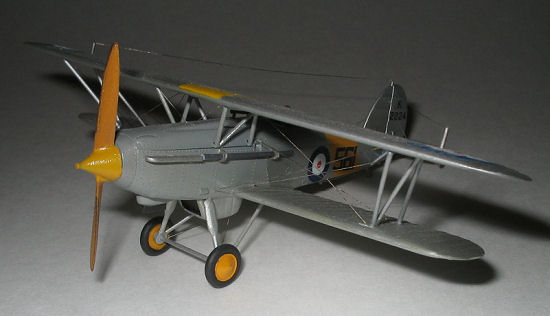 h Republicans, all had
this gear. Guano Aeroplane and Zeppelin Works, of Seattle, produced a limited
run conversion kit for the Yugoslav Fury. This includes instructions on the
conversion, including a new landing gear, radiator some airscoops, and underwing
mountings for additional armament. The instructions state that additional decals
are available for this and other Yugoslav aircraft from Guano, but I haven’t
heard about them for years. So I don’t know if they are still available. Guano
produced a short run Ikarus IK-2 many years ago that was really a pretty nice
kit.
h Republicans, all had
this gear. Guano Aeroplane and Zeppelin Works, of Seattle, produced a limited
run conversion kit for the Yugoslav Fury. This includes instructions on the
conversion, including a new landing gear, radiator some airscoops, and underwing
mountings for additional armament. The instructions state that additional decals
are available for this and other Yugoslav aircraft from Guano, but I haven’t
heard about them for years. So I don’t know if they are still available. Guano
produced a short run Ikarus IK-2 many years ago that was really a pretty nice
kit.
Microscale produced a decal sheet for this aircraft a number of years ago, covering a number of RAF versions. This was sheet Number 72-143, and provided decals for a Fury of No. 1 Squadron, based at Tangmere in 1931, and a camouflaged Fury of No. 43 Sqdn. during the Munich Crisis in Sept. 1938. This provides some interesting markings, including the black and white undersides and an early “sand and spinach” topside scheme later adopted for RAF fighters during World War II. The sheet also provides decals for three Gladiators. However, standard decal sheets are useful in modeling most of the variants of the Fury that can be modeled. A little scrounging experience is helpful here.
| REFERENCES |
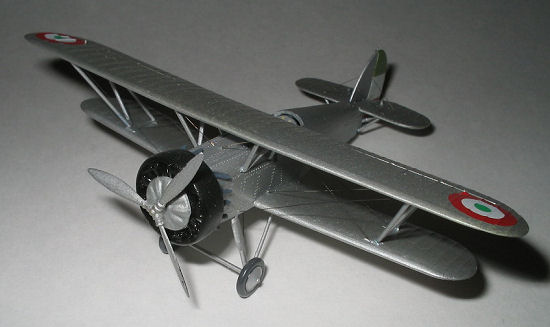 Sources
of information are plentiful on this aircraft. There are some good cutaway
drawings on this plane published in numerous aviation books, and other sources
have a variety of color schemes. Although all of my models were built before
the internet, I would suspect that logging on to Google and searching for Hawker
Fury would generate a lot of information, although it must be remembered that
Hawker also produced a Fury towards the end of the war that became well known in
its naval guise, the Sea Fury, which is, of course, an entirely different
aircraft.
Sources
of information are plentiful on this aircraft. There are some good cutaway
drawings on this plane published in numerous aviation books, and other sources
have a variety of color schemes. Although all of my models were built before
the internet, I would suspect that logging on to Google and searching for Hawker
Fury would generate a lot of information, although it must be remembered that
Hawker also produced a Fury towards the end of the war that became well known in
its naval guise, the Sea Fury, which is, of course, an entirely different
aircraft.
In addition, the following sources are useful: (Not in any particular order)
Mason, Francis K. The Hawker Fury.. Surrey, UK: Profile Publications Ltd. 1965.
Good basic coverage on Mk. I, but some information appears to be dated.
Goulding, James. And Richard I. Ward. Gladiator, Gauntlet, Fury, & Demon.
Camouflage & Markings, No. 5. London: Dulcimas, Date Unknown. (1970’s?)
& Markings, No. 5. London: Dulcimas, Date Unknown. (1970’s?)
Good color material on RAF Furies. Photos of Mk. I and II.
Gunston, Bill. The Encyclopedia of the World’s Combat Aircraft. New York: Chartwell Books, 1976.
Brief coverage on Fury I and a color view of a No. 1 Sqdn Fury and a Danish Nimrod.
Thetford, Owen. Aircraft of the Royal Air Force since 1918. New York: Funk & Wagnalls, 1968.
Good coverage of all RAF variants. Nothing on export versions and RN Nimrod.
Green, William, and Gordon Swanborough, Flying Colors.. Carrollton, TX: Squadron/Signal Publications, 1981.
Good color coverage of RAF, SAAF, and Portuguese Fury I’s. Also Spanish and Yugoslav Furies.
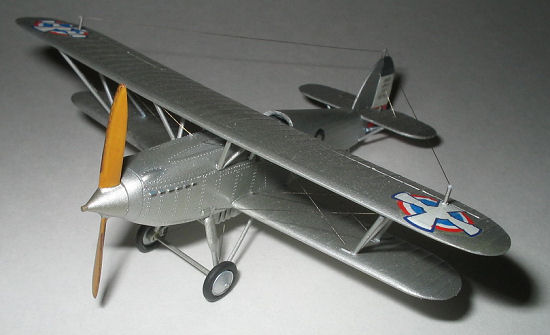 Wheeler, Barry C.
Military Aircraft Markings and Profiles. New York: Gallery Books,1990.
Actually a repeat of the information in the Green-Swanborough
book.
Wheeler, Barry C.
Military Aircraft Markings and Profiles. New York: Gallery Books,1990.
Actually a repeat of the information in the Green-Swanborough
book.
Green, William, and Gordon Swanborough. The World’s Great Fighter Aircraft. New York, Crescent Books, 1981.
Some data and an excellent cutaway showing extensive cockpit detail, but no instrument panel.
Green, William, and Gordon Swanborough. The Great Book of Fighters. Osceola, WI: MBI Publishing Company, 2001.
Very authoritative coverage of nearly every fighter aircraft ever built and flown. Extensive material on all Fury variants including the P.V.3 steam cooler Goshawk Powered version. Color drawings duplicated in other G & S books listed above.
| CONCLUSIONS |
In all, this is a real classic kit, and I have built a bunch of them over the years. I have bought them in stores and swap meets, and they are inexpensive. They are suitable for a beginning modeler to learn how to assemble biplanes without the traumatic frustrations usually associated with biplanes. This model belongs in the collection of any serious 1/72 scale modeler.
THE MODELS (Not all are shown)
THE BRITISH VERSIONS
Fury. K3731. No. 43 Sqdn. RAF. Tangmere, circa 1931. Aircraft was silver overall with black and white checkerboard squadron markings. (Modified kit Decals.)
Fury. K5673. No. 1 Sqdn., RAF. Tangmere, 1931.. Aircraft was silver with red squadron markings. (Microscale Decals)
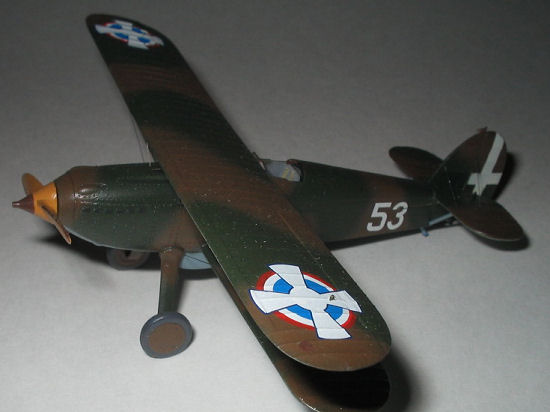 Fury Serial
Unknown. No. 43 Sqdn. Tangmere. At time of Munich Crisis, 1938.
Aircraft were camouflaged in green and brown over
black, white, and possibly silver. (Spare decals, although Microscale later
included this aircraft on its 72-143 issue.)
Fury Serial
Unknown. No. 43 Sqdn. Tangmere. At time of Munich Crisis, 1938.
Aircraft were camouflaged in green and brown over
black, white, and possibly silver. (Spare decals, although Microscale later
included this aircraft on its 72-143 issue.)
Fury K3736. S Flying Training School, Sealand, 1938. Aircraft overall yellow with silver cowling. (Spare decals from Profile reference.)
Fury II K7270. No. 25 Sqdn. Hawkinge, 1936. Standard overall silver with black squadron markings and wheel pants from the spares box.
Nimrod K2874. Royal Navy version with incorrect wing. (It was actually Swept back similar to the Hart and Demon wing.) Otherwise accurate.
THE EXPORT VERSIONS
Fury White M, 217. South African Air Force. Used in East Africa against Italians in 1939-1940. Standard camouflage.
Fury White 401. Sole Norwegian Fury with Panther radial engine. Spares Box modification with masked insignia and spares box decals.
Fury Unmarked. Persian Hornet Fury. Powered by Pratt & Whitney Hornet, these engines were replaced by Bristol Mercury units later in their career. Some of these aircraft carried very colorful markings.
Fury Yugoslav Fury, British production. Black 2. Silver overall. One of the first 6 Fury fighters to be delivered to Yugoslavia, circa 1931.
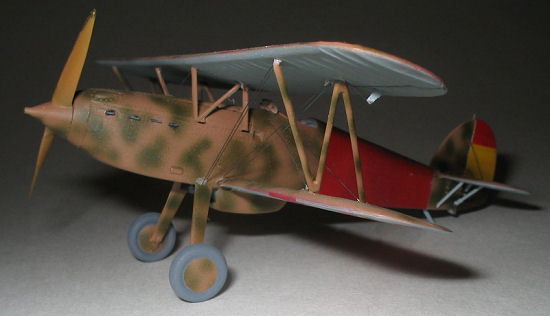 Yugoslav
Fury Black 45. This aircraft had the cantilever landing gear
which appeared on Yugoslav production models. Yugoslavia, middle 1930’s.
Yugoslav
Fury Black 45. This aircraft had the cantilever landing gear
which appeared on Yugoslav production models. Yugoslavia, middle 1930’s.
Yugoslav Fury White 45. Might be same aircraft as above after camouflage. Yugoslavia, circa 1940.
Yugoslav Fury No number. Used by Spanish Republicans during Spanish Civil War. Survivors went to Franco’s Air Force and operated in their markings.
Yugoslav Fury White 33. Ex Yugoslav Air Force aircraft acquired by the Italians for use as a fighter trainer, about 1941. Note that Italian rudder cross is used, but the original Yugoslav roundels remain on the wings.
These are some of the Furies I have built over the years. They are a lot of fun to build.
February 2006
Copyright ModelingMadness.com. All rights reserved. No reproduction in part or in whole without express permission.
If you would like your product reviewed fairly and fairly quickly, please contact the editor or see other details in the Note to Contributors.